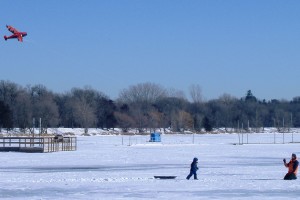
Lake Harriet in Winter by Amy Mingo. Licensed under CC BY 2.0
Amazon has been doing post-mortems with various cities that did not make the first cut in the HQ2 sweepstakes. One of the cities that was surprising by its absence from the list of 20 was Minneapolis. However, as people pointed out, Minneapolis-St. Paul is already home to traditional retailers Target and Best Buy (no fans of Amazon), and did not offer an especially generous incentive package.
Yet MSP’s post-mortem was supposedly that Amazon didn’t think they could recruit enough tech talent there quickly enough. Matt Yglesias tweeted this in response.
Americans’ stubborn refusal to move to Minneapolis (presumably because it’s cold) despite the very advantageous ratio of wages to housing costs is a very funny quirk of contemporary urban economics.
Bezos thinks it’s easier to tackle space travel than change this. https://t.co/5fSvHJRxWM
— Matthew Yglesias (@mattyglesias) May 6, 2018
Minneapolis likes to think of itself as different from the Midwest, a view many other Midwesterners share. But it shares the Midwestern trait of underperforming in attraction relative to its putative advantages.
Compare MSP to metro Denver and Seattle. Denver has had net domestic migration of 160,283 this decade. Higher cost Seattle has seen net domestic migration of 125,804. But MSP’s net domestic migration is only 2,984.
If we look solely at in-migrants, the gap is less stark but still notable. Using IRS tax return data, since 2010, metro Seattle had 676,240 in-migrants, Denver 563,211, and MSP 400,748.
Cold surely does play a role. I might suggest that reputation often lags reality, so that the marketplace view of Midwestern cities like Minneapolis that are doing well may not yet full match reality.
But I wouldn’t be so quick to blame everything on the cold. I used to travel there quite a bit and wrote in 2010:
In short, while I really like the city and think I might enjoy living in it, I’m not entirely comfortable there. And I know I’m not the only one. I know multiple people who moved to Minneapolis and left it because of difficulty fitting in or penetrating the social structures there.
I’m not sure my diagnosis of why I didn’t quite feel comfortable there is correct, but I do believe there is something to the local culture in these places that inhibits attraction.
When I first started visiting Nashville I tried to figure out what they had that Midwest cities that weren’t growing as fast economically or in population didn’t. Honestly, in terms of checkbox items, Nashville had nothing on places like Indianapolis or Columbus. But there must be something.
Consider: Nashville just voted down a $5.4 billion transit system. I am on record as saying the system made no sense for them. Yet clearly this was an audacious, forwarding looking proposal designed to change the game.
By contrast, Louisville, Kentucky decided to double down on dumb by rejecting a proposal to tear down its riverfront freeway and reconnect downtown to the riverfront in favor of a gigantic downtown freeway expansion.
Indianapolis is in the process of doing the same thing. Indiana’s state highway department wants to widen and expand the downtown freeway ring and right now it looks like as with Louisville, only citizen groups are in opposition – meaning they will likely get steamrolled.
What characteristic of these places make Nashville want to build a huge if unwarranted light rail system and Louisville and Indy to keep building downtown highways like it’s still 1974? I don’t know for sure, but it’s got to be something.
Midwest cities, including ones like Minneapolis that like to think pretty highly of themselves, ought to do some serious soul-searching and cultural analysis to find out what besides the usual suspects of weather, greenfield economics, and lagging reputations might account for their relative lack of attractiveness to newcomers.
from Aaron M. Renn
http://www.urbanophile.com/2018/05/08/its-not-just-the-weather/
No comments:
Post a Comment